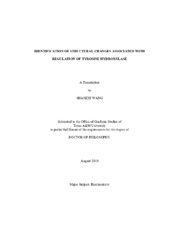| dc.description.abstract | Tyrosine hydroxylase (TyrH) is the first and rate-limiting enzyme of
catecholamine synthetic pathway, and its regulation is critical for controlling
catecholamine synthesis. The well recognized regulatory mechanisms are inhibition by
catecholamine binding and re-activation upon Ser40 phosphorylation. Catecholamines
bind to TyrH tightly, while phosphorylation of TyrH at Ser40 decreases the binding
affinity by several hundred-fold. Regulation of TyrH is accompanied by conformational
changes of the protein. This study focuses on the identification of the conformational
changes of TyrH upon dopamine binding and Ser40 phosphorylation, using hydrogen
deuterium exchange mass spectrometry (HDMS) and fluorescence spectroscopy.
HDMS identifies three peptides undergoing conformational changes upon
dopamine binding, peptide 35-41, 42-71 and 295-299. Peptides 35-41 and 42-71 are on
the regulatory domain, while peptide 295-299 is at the active site entrance. Upon
dopamine binding, all three peptides are protected from exchange; phosphorylation of
TyrH at Ser40 has opposite effects on the exchange kinetics of peptide 295-299, but
peptides 35-41 and 42-71 could not be detected by MS after phosphorylation. This suggests that the structural effects of dopamine binding and Ser40 phosphorylation are
opposite.
The fluorescence spectroscopy of mutant enzymes containing a single tryptophan
at position 14, 34 or 74 was performed before and after phosphorylation. F34W/F3W
TyrH has a significant decrease in steady-state fluorescence anisotropy, an increase in
the bimolecular quenching rate constant kq and dynamic anisotropy upon
phosphorylation at Ser40, while F14W/F3W TyrH and F74W/F3W TyrH exhibit much
smaller differences. This suggests that phosphorylation of TyrH at Ser40 increases the
flexibility of the regulatory domain.
The results are consistent with TyrH existing in two conformations, a closed
conformation stabilized by dopamine in which the N-terminal regulator domain of TyrH
covers the active site entrance and an open conformation stabilized by phosphorylation
in which the regulatory domain has moved away from the active site entrance. | en |


